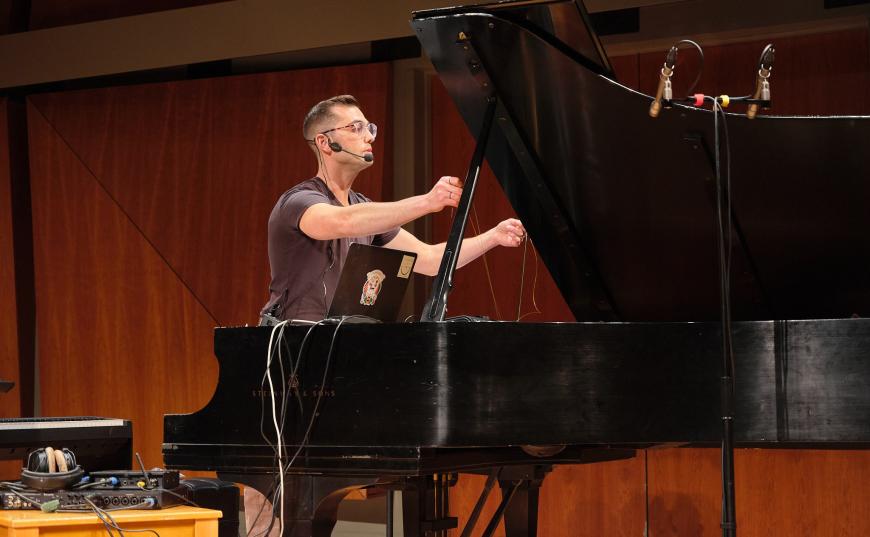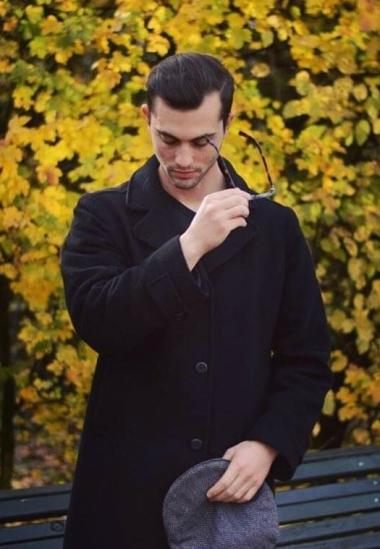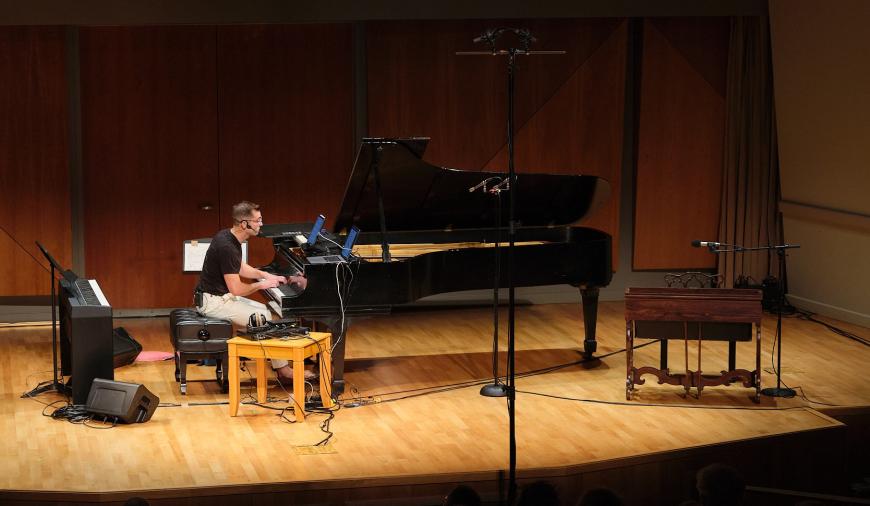
In one sense, young pianist/vocalist/composer Daniel Newman-Lessler fits neatly into the contemporary-music continuum of Los Angeles’ long-running Piano Spheres series. He is a gifted and versatile player with fingers on assorted contemporary musical pulses and also a protege of veteran Piano Spheres performer Vicki Ray, with whom he studies at CalArts.
But Newman-Lessler was also an anomaly and semi-apostate in his Tuesday night (Oct.18) recital at the Colburn School’s Thayer Hall. Whereas the grand old grand piano is generally the focus of the series, Newman-Lessler ushered in a diverse palette of digital elements, electronic keyboards, and music-making tactics extending beyond standard piano practice.
It’s all part and parcel of his restless quest for experimental and conceptual ventures, gathered here into a 13-piece program called “Transparent Animals,” one of this season’s “Emerging Artist” events. As Newman-Lessler explained to the Colburn audience, the curatorial focus here was on music that wears its intentions in an exoskeletal way, or in architectural terms, is akin to something “industrial and Brutalist. The guts are on the outside.”

Such a notion was best illustrated by Dan Trueman’s entrancing fool-the-ear piece Wending Embers, a Piano Spheres-commissioned world premiere. For the work, Newman-Lessler turned his attentions to the unique bitKlavier, described as a “prepared digital piano,” which Trueman helped develop. The instrument combines physical string attributes with flexible margins for digital manipulation.
In this case, a surreal sonic mesh is created between the relatively simple, consonant piano material and an odd coupling of altered resonances and microtonal shifts on the digital side. The mixological magic — with its resonant “guts on the outside” — occurs in the space between those conflicting domains.
Two organic works dodging both standard piano and digital tools framed the variety pack of pieces in “Transparent Animals.” As a calm, breathy prelude to the set, Catherine Lamb’s … as two … or three … or four … found the performer playing drones by bowing piano strings and by throat-singing. The actual show-closer was an encore on the 19th century-invented, foot pump-driven melodion, with Newman-Lessler singing an original song — a lamenting cautionary tale about a period during the pandemic when he struggled with chronic hand and wrist pain.
“What would I do if I ruined my hands?” he sang, a provocative musical question wrapped in an infectious melodic turn. The question struck a note of fear in any musician in the room and left listeners with a quirky earworm as they exited the hall.
The relationship between voice and piano took a different turn in works by Pamela Z and a pair of pieces from Peter Ablinger’s Voices and Piano series. Both composers follow similar tacks to Paul DeMarinis’s Music as a Second Language, in which spoken texts are mated, in strict yet dreamlike fashion, with synchronized melodic material. The text for Pamela Z’s Notice of Baggage Inspection consists of TSA guidelines tethered to spidery piano lies in rhythmic unison. Ablinger flies in rough-hewn archival speech material as a bedfellow to the piano music, pure or gruffly altered (to intense ends in Valentina Tereshkova).

Two pieces from Matthew Shlomowitz’s Popular Contexts series melded willfully simplistic piano parts with fragmented digital borrowings from the quotidian and pop-culture worlds, asking us to reexamine our relationship to everyday aural experiences. While the works are fun-loving with a deeper purpose, the composer’s reliance on slice-and-dice sample-play felt a bit anachronistic.
From deeper in the compositional archives, Newman-Lessler called on Julius Eastman’s Joy Boy (1974) — a ruffian minimalist work ahead of its time, here arranged for shimmering piano tremolos and iridescent effects from the performer’s voice sent through a computer patch created by Alex Hawthorn. The evening’s second-oldest work was Beat Furrer’s 1986 Voicelessness (The Snow Has No Voice). The title taken from a Sylvia Plath poem, it is a slowly evolving, beguiling, Morton Feldman-esque work, which, in the pianist’s patient hands, achieved a state of ruminative objectivity.
Another long piece on a program of mostly compact scores was Frederic Rzewski’s curious Rubinstein in Berlin (2008). Generous doses of Chopin’s Nocturne in C-sharp Minor filter through the work, which ventures in and outward, requiring the performer to recite passages from Arthur Rubinstein’s autobiography, reflectively grousing about the iconic pianist’s early years. For comic relief, a whoopee cushion is also deployed. For the multitasking Newman-Lessler, combining voice with piano, and all other manner of extra-piano sources, seems to come easily.
In terms of the most concentrated actual piano content on this generous program, ulterior motives and aspects were also at play. In the cathartic density of Karen Tanaka’s Techno Etudes 1: No, 1, the primary influence was the drive and emotional neutrality of techno music. To close the official program, Newman-Lessler dove into Mac Waters’s cheekily named pop music, building up both real time and live-processed delayed piano sounds into a deliciously chaotic mass of keyboard notes gone wild.
It was a fitting finale to the barefooted player’s well-played thicket of music and ideas.


